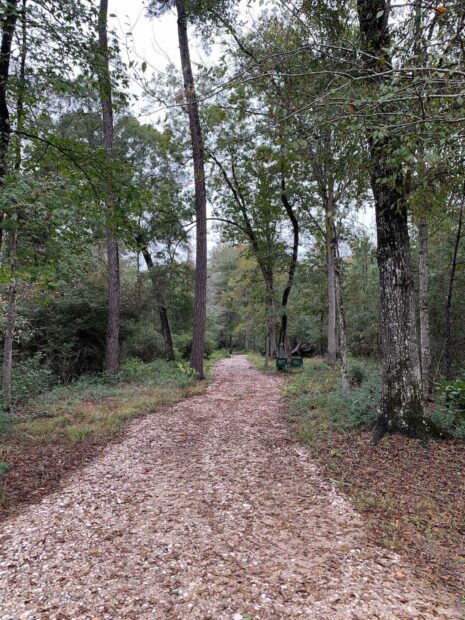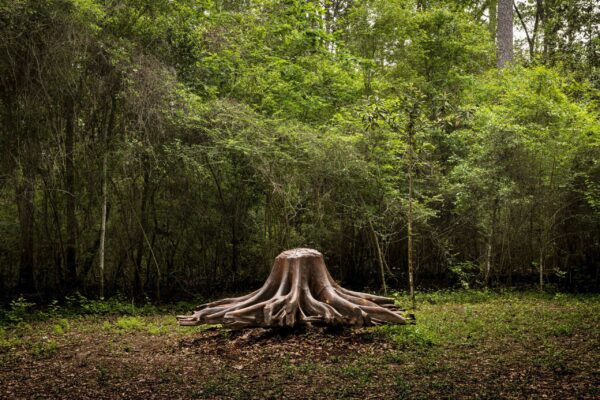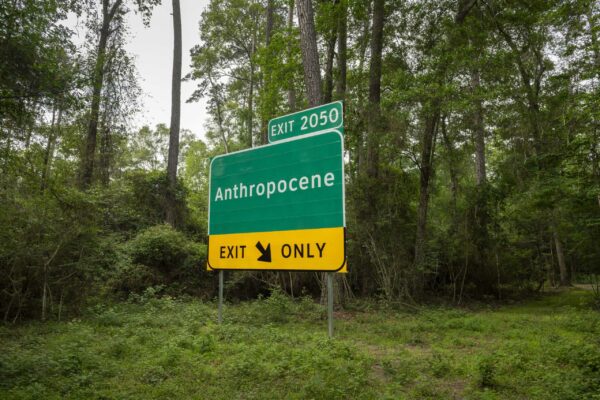Place has an outsized impact on art. There are many shows I’ve seen for which I can recall exactly how the gallery space — the layout, the wall color, the feel of the place — influenced not only the visitor experience, but the success of the presentation. This is especially true in nontraditional settings — artist-run galleries, abandoned buildings, warehouses, and apartment front rooms. Usually these spaces are more forgiving; they have a uniqueness about them that imbues the work itself, seeping into the ethos of the show.
So too is the case of outdoor sculpture parks. Picturesque settings with sightlines and beautiful tableaux framing large-scale outdoor artworks are hard to beat. Once you see the misty mountain vistas and changing tree colors of the Storm King Art Center (which lives up to the hype) or the rolling, beautifully landscaped pathways of Glenstone (so I’ve heard; it’s on my list), it is hard to go back to a clean, sterile, white-walled gallery.
Art comes from nature, and divorcing the two, if possible, should be avoided. This is why the architecture of Houston’s Menil Collection incorporates glass walls, bringing foliage into the museum. It is also why so many artists are plant lovers and oftentimes paint portraits of or make works paying homage to their green-leafed friends.
Creating wider art-plus-nature experiences is harder in Texas than in other places, namely because of our state’s propensity for inhospitableness. Sure, you have Laguna Gloria in Austin, which weaves works by a pantheon of well-known artists into a lush landscape, but even it has to compete with the Texas weather for half of the year. The same goes for Texas’ other bastions of outdoor art, including the Chinati Foundation in Marfa and the wonderfully groomed Nasher Sculpture Center in Dallas. Moreover, unless you’ve been in and traveled around our state, it is hard to pinpoint what actually defines a Texas landscape.
In my years traversing the state, I’ve come to think that its most unique area, perhaps even more so than the rocky cliffs of West Texas, is East Texas’ piney woods. The region is marked by the tall, thin, eponymous trees that blanket the ground with their signature brown needles. It is this landscape, which is in full force just 40 miles northeast of Houston but feels a world away, in which DiverseWorks’ A Gift from the Bower is hosted, tucked away in the newly rebranded Locke Surls Center For Art And Nature (LSCAN) (formerly Splendora Gardens).
Comprised of 177 acres and including a large-scale barn, outdoor artworks, and multiple new buildings, LSCAN was the home of Charmaine Locke and James Surls from the 1970s to the 90s. The property was reinvigorated in 2016, when Texas artist Jeff Wheeler was brought in to collaboratively program the site with Surls and one of his daughters, Ruby. A year later, Alton DuLaney, who is today the director and curator of the Houston Airport System’s public art program (and also in A Gift from the Bower), was brought in to run the space. In the years since, LSCAN (namely the large-scale barn, which was Surls’ former studio) has been activated for occasional programs. The current show, however, which was, according to DiverseWorks, “originally conceived by artists James Surls and Charmaine Locke [and is] co-curated by Jack Massing and Xandra Eden,” is the most significant project at the space to date.
Featuring work by 14 artists and collaboratives, the show is based on and installed throughout naturally occurring bowers (clearings) along a half-mile pathway through LSCAN’s woods. The exhibition begs the question of how artworks change, both in their messages and in our perception of them, when they’re installed harmoniously with nature.
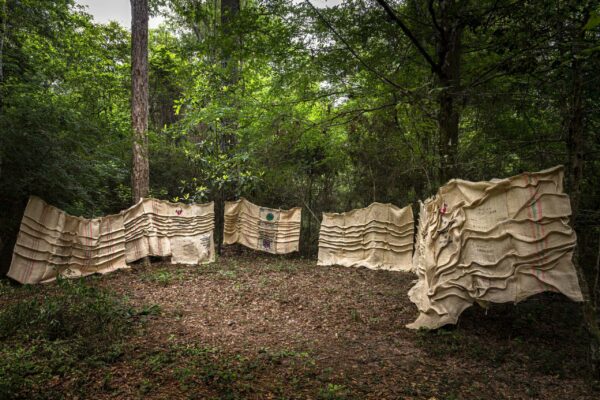
Kaneem Smith, “IT MADE A SOUND BECAUSE GOD HEARD IT,” 2023, burlap, steel, and brass. Photo: Paul Hester.
The most significant marker of the show is the tandem commitment of space and time. There is no dropping in — you have to venture north of Houston, to Cleveland, to visit. And then once you’re out there, the show requires you to engage with the landscape. Some of the bowers, which are denoted by signposts, are so far off the trail that the enclosed sculpture is obscured by branches, leaves, and tree trunks. The woods becomes an unlisted component of the artwork; it isn’t only a backdrop, but is a necessary component, situating the pieces in a specific place and time. It makes the work contemporary to whenever you’re experiencing it.
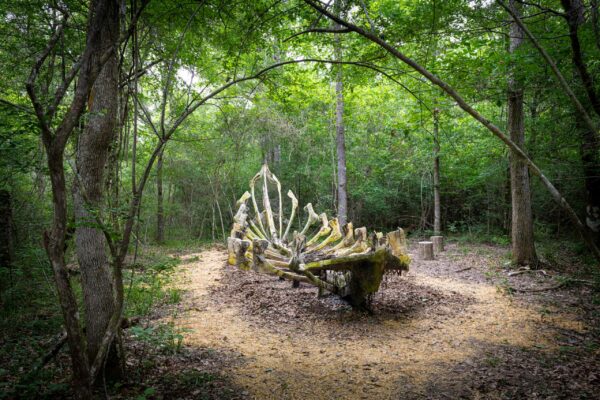
Sharon Kopriva, “Bower Boat,” 2023, wood, found objects, resin over mache, plaster and metal screen. Photo: Paul Hester.
In some instances, this aesthetic of site-specificity (I’d dare to say none of these works would be as successful in a gallery) is particularly poignant. Sharon Kopriva’s Bower Boat is the skeleton of a viking ship. It’s uncanny to encounter the piece so far from any visible body of water, and in her signature style, Kopriva’s treatment of the work makes it a vestige from a now-extinct culture. An otherworldliness emanates from a giant egg, which sits in the middle of a similarly large nest in the center of the boat. The agedness of the scene makes the sculpture a relic, but the care and upkeep of its site emanates the feeling of a sacred space.
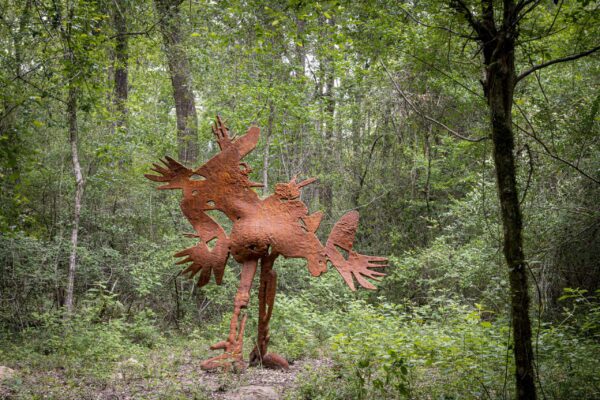
John Calaway, “Bird of Pray,” 2022, polycarbonate, stainless steel and iron infused paint. Photo: Paul Hester.
John Calaway’s Bird of Pray, one bower over from Kopriva’s boat, is the creature that may have laid the egg. Casually strolling through the woods, walking out of the clearing and towards the main path, the piece is a contemporary take on modernism. There are elements of Pablo Picasso and Joan Miró, but the work is more fluid and imbued with a slight humor; it is a roughed-up rooster, feathers akimbo and wings spread, that is casually strolling to greet you.
The character is a bit of a trickster, as is the piece itself — it is made not of metal, but of polycarbonate that has been coated with iron-infused paint. The plasticity of the polycarbonate somehow comes through in a way that makes the piece feel down to earth; the work puts on the trappings of what a large-scale sculpture should be, but then undercuts them at every turn. It chose a language of relatability rather than monumentality, a feat considering the creature easily towers over the average visitor and could, in any other circumstance, come off as menacing.
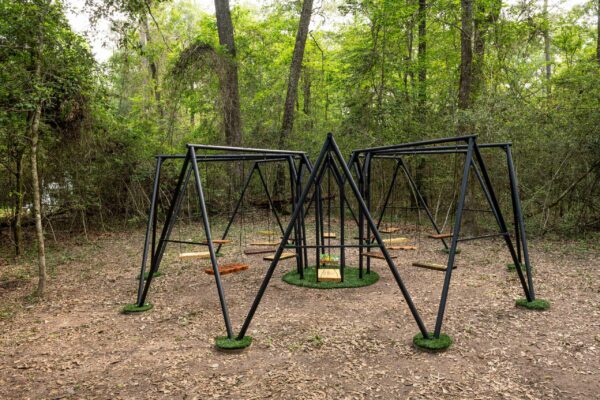
Leticia R. Bajuyo, “Swing Set: Share a Share (Duyan: Ibahagi ang Balato),” 2023, steel, wood, concrete and artificial turf. Photo: Paul Hester.
Further along into the woods, Leticia R. Bajuyo’s installation of a multi-legged, circular swing set masquerades as a larger-than-life spider. With A-frame poles encircling the installation, the swings are challenging to access for a visitor, which begs the question if the piece is meant to be static, an exercise in absence, or if the work does invite engagement. This was answered during the show’s opening reception, back in April, when a group of Filipinx artists (who had also each designed individual seats for the swing set) activated the piece. In addition to swinging on it, they used the structure’s poles as a percussive instrument, filling the forest’s natural soundscape with metallic clinks and clangs. The sculpture, whether activated or not, is a bold statement that the individual artists who contributed to it are here to share their stories and aren’t going anywhere.
While Bajuyo, Calaway, and Kopriva’s interventions in the bowers are more obvious because of their chosen mediums, other artists went with a (no less impactful) subtler, natural approach. For example, Ronald L. Jones, who is best known for his site-specific immersive installations using colored string, made a heart-shaped almost-maze out of wooden pallets. The installation works in part because it isn’t out of sync with the landscape; instead, it somehow looks as if it could’ve been in the forest all along. It is a repurposed cabin, the start of a larger project undertaken by bored youths over the summer, or even a clubhouse deconstructed.
Similarly, James Surls’ Oak Stump is perhaps the most silently poetic work in the show. The clearing for the piece is fairly far off of the main path, meaning that it has a sort of camouflage when seen from there. Subsequently, the way that the path to the sculpture opens up into a clearing much larger than any other in the show makes Surls’ the most dramatic bower of the bunch. In it, surrounded by mature trees and saplings, is a slightly modified large-scale stump of an oak, which comes from a tree that was blown down during a 1983 hurricane that came through Splendora. Surls used the trunk for other artworks and then shaved and saved the stump before ultimately deciding to return it, in its revised, sculptural form, to its home.
Although Surls surely left his mark on the stump — it looks out of place and naked among the thriving woods — it is also fair to say that the idea for the sculpture, the inherent smartness and beauty of it, is nature’s alone. The power of having the final bower be Surls’ is that he hands you the concept of the show on a silver platter; if you don’t understand yet, here is your prime chance.
Artwork shouldn’t compete with nature, namely because the competition is unfair and nature will inevitably win out. The curation of A Gift from the Bower notes this and agrees with it, and instead allows the included artists to approach their responses to the woods in three ways: subtle touches (Surls and Jones, among others), more obvious complementation (Bajuyo, Calaway, and Kopriva, among others), and complete fish out of water plop art (Carlos Canul & Rachel Gardner and Jack Massing). All three tactics work, pointedly because none of the included artists try to flirt with a center lane; they all make strong choices that are right for their particular pieces.

Inside LSCAN’s barn is Lina Dib’s 20-channel sound installation, “North to South and Back: flights, flood fields and sticks,” 2023
This sentiment is laid bare by the inclusion of a work in LSCAN’s barn by Lina Dib, who has become known throughout Houston for her audio installations. The 20-channel sound piece, featuring a mix of natural bird calls and imitations of bird calls by people who have immigrated to Houston, plays amongst Surls and Locke’s artworks, which are installed throughout the space. Instead of situating Dib’s work outdoors, where it would’ve both gotten lost and also interrupted the natural stillness of the woods, the audio piece is placed in its own sculpture forest, which is made up, most likely, of wood taken from this very property 40 years ago.
Dib’s piece is just another example of the full cycle that this show represents — of art, of our lives, and of nature. In a world where the sustainability of natural resources and the imminence of climate change are regular conversations, it has become inherently political to do an exhibition such as this one. Even though the lion’s share of the artwork in the show isn’t explicitly taking sides, anything arguing for the precarity, beauty, and worthiness of the world around us is a reminder that life, and not art, is what’s truly important. It is both poignant and rewarding to think of this as you’re surrounded by smart sculptures and taking in the anomalous woods that make up East Texas.
A Gift from the Bower is organized by DiverseWorks and on view at the Locke Surls Center For Art And Nature (26041 Midline Rd, Cleveland, TX 77328). The project was originally conceived by artists James Surls and Charmaine Locke and is co-curated by Jack Massing and DiverseWorks Executive Director Xandra Eden. The exhibition features work by Leticia R. Bajuyo, Susan Budge and George Tobolowsky, John Calaway, Carlos Canul and Rachel Gardner, Lina Dib, Alton DuLaney, Ronald L. Jones, Sharon Kopriva, Charmaine Locke, Jack Massing, Sherry Owens and Art Shirer, Patrick Renner, Kaneem Smith, and James Surls.
The show is on view through November 18, 2023. A closing potluck is scheduled for noon on November 18, followed by a performance by Richard (Dickie) Landry at 2 p.m.


